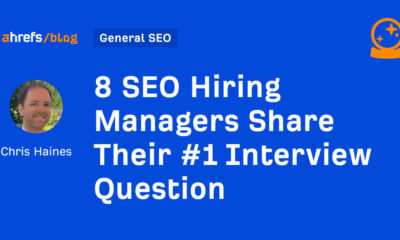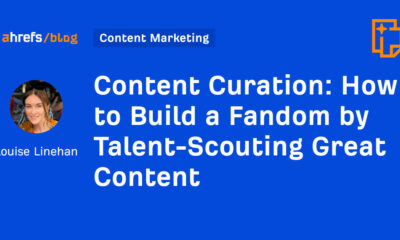MARKETING
How a Silly Content Question Led to Surprisingly Delicious Answers

It wasn’t a great question.
But we asked it anyway: “Does it matter if people consume the content, or is it enough for them to notice it?”
To make matters worse, we posed the question to the experts presenting at Content Marketing World 2022. Yeah, the people sharing ideas with content marketers (who presumably want their content consumed).
To our delight, the experts took this less-than-stellar query and returned something even better than we’d hoped – frank contemplations, food for thought, and, sure, plenty of sass.
You don’t just eat with your eyes
Oh lord. Of course, it matters if people consume your content. That’s like asking a chef if it matters if people consume the food or look at it. – Andrew Davis, author and keynote speaker, Monumental Shift
Offer taste testers more than one course
If you’re building brand awareness, the relationship often starts with engineering a dozen micro touchpoints where your content is just enough to stop the scroll or get your audience to look twice. But it’s important that your scroll-stopping content ultimately leads your audience to find out more – and seek out your content to consume.
Then the challenge is: How do you make them return for more content?
Being consistent with your message is key to achieving this and ensuring that there is a clear path your audience can take with your content, from bite-sized snackable content to longer-form, informative pieces. You can achieve this with well-planned content repurposing.
It’s a little like serving up different courses in a meal. Learn how to take your audience from taste tester to content consumer with our guide, How Content Repurposing Makes Your Customer Journey a 7 Course Fine Dining Experience. – Amy Woods, founder and CEO, Content 10x
Don’t be the noticed-but-ignored burger truck
If audiences notice it and then choose not to consume it, chances are there’s an issue with the message, the design, or the targeting. If I’m at a food truck park and I notice the burger truck every single time but actively choose to order food from the Cajun truck, my notice doesn’t matter to the burger people. Same thing if I notice one piece of content but then consume another. – Andrea Fryrear, CEO and co-founder, AgileSherpas
If audiences notice your #content but don’t consume it, there’s a problem with your message, design, or targeting, says @AndreaFryrear via @AnnGynn @CMIContent #CMWorld Click To Tweet
Tempt with aromas, but get them to buy dinner
Is it enough for people to walk by a restaurant and think it smells good? Or do you want them to buy dinner? Ultimately, the more sales you make, the better off you are. However, to continue the analogy, some of those sales may come from people who previously walked by and inhaled a delectable scent.
Simply noticing content involves consuming some of it – perhaps a headline, an image, or a logo. With repeated exposure, a person may decide to dive deeper.
That said, I always aim for notice and consume. If your content is well targeted, you want those targets to engage with it – and respond to it – because that’s what can lead to business. And at the end of the day, isn’t that what most of us want? – Nancy Harhut, CCO, HBT Marketing
Give them more than one bite
Of course, you want your audience to consume your content. That’s the point of content marketing. Content marketing is providing content to the target audience to help them reach professional goals, educate, entertain, or address whatever content needs they might have.
If your content is designed to meet those goals, you want your audience to have a close and intimate relationship with it. We want them to appreciate it and be grateful for it. We want them to depend on it. We want them to be hungry for more.
This will – depending on your goals – induce brand trust, build experts’ personal branding, or simply create a positive association. Unless your content is so bad, you hope nobody will read it in full. – Igor Bielobadek, digital marketing senior manager, Deloitte
Don’t add to clickbait content noise
Look, it’s better to be noticed than not noticed. But of course, consumption matters. The world’s attention is incredibly divided, yes. And it’s hard to get noticed. But vying just to get noticed means that you’re adding to the clickbait, junk-content noise that already prevails.
If all you’re doing is vying for attention, you’re not giving value to your audience. And great relationships are built on value. Think about your own day-to-day – probably thousands of things catch your attention for a few seconds. But they leave your brain the minute you look away. Creating meaningful interactions is the key to forging a great relationship with your audience. You can’t do that with hand waving. – Inbar Yagur, vice president of marketing, GrowthSpace
If all you’re doing is vying for attention, you’re not giving value to your audience, says @Content_Fairy via @AnnGynn @CMIContent #CMWorld Click To Tweet
More awareness equals a bigger audience
I love this question because it calls attention to a timeless marketing principle: AIDA. The first A stands for awareness. (The rest stands for interest, desire, and action.)
While it’s great for your super fans to consume your content, there’s greater value in more people in your target audience noticing it, provided that it reinforces the main thing about your brand. This keeps your brand top of mind, which leads to higher sales conversions in the long run. – Bernie Borges, vice president global content marketing, iQor
Do you want their minds?
Like all good content questions, the answer is “it depends.” If you’re going for brand awareness, noticing content is enough. If you want to change hearts and minds, content must be consumed and engaged with.
But if your goal is to sell, even if the content is only consumed at a surface level (i.e., skim-read or watched to 25%) but still converts, does it really matter? To a content creator, yes. To the business, probably not. – Gina Balarin, director and content queen, Verballistics
Notice, then consume
As someone who has over 80 tabs open at all times, I can assure you that if I’ve noticed good content, I’ll consume it. I also DM myself on Twitter and IG, save TikToks, etc.
Catching the eye is great, but the ROI of content marketing comes when folks read and engage with your content. – Jenn VandeZande, editor-in-chief, SAP Customer Experience
Catching the eye is great, but #ContentMarketing ROI comes when folks read and engage, says @JennVZande via @AnnGynn @CMIContent #CMWorld Click To Tweet
Sow content seeds
In January, I noticed a garden seed company sharing information about container gardens. When I was ready to plan my container garden in March, I went back to the company to learn more about the right plants for my growing zone and container size. When I planted the garden in May, I went back again to purchase materials. People need the right information at the right time.
Often people notice a source that offers helpful, insightful content and are more likely to remember the brand and the type of information they share. When a need arises, people can go back to that brand for educational information and purchase details. – Penny Gralewski, senior director, product and portfolio marketing, DataRobot
Know the stop on the journey
If you are looking to create brand awareness or ad recall, it might be enough for people to notice it without taking any action. If you are targeting people early in the customer journey when awareness is your major goal, they may not act on your content, and that is OK. If you target users further down the funnel or have a goal that involves the user doing something with your content (clicking, sharing, etc.), then just noticing it will not help you reach your goals. – Andi Robinson, global digital content marketing, Corteva Agriscience
If you’re targeting people early in their customer journey, they may not act on your #Content, and that’s OK, says @HijinxMarketing via @AnnGynn @CMIContent. #CMWorld Click To Tweet
Make a dent or generate leads
It depends entirely on your foundational goals. If you’re simply trying to build awareness of your existence, then people noticing your presence – preferably on a repeated basis – may be enough to make a dent.
But if you’re trying to generate leads, built trust, or create loyalty, you need true engagement.
Think about how-to content that helps solve a customer’s problem or need, for example. If that customer simply sees it, well, that’s a good start. But if they consume the content, then come back for more, you’re on the way to creating trust and loyalty. – Chris Blose, founder, Chris Blose Content
Go down the attention funnel
We often talk about the sales funnel. Here, I’ll introduce the concept of the “attention funnel.” While we’d always prefer that users consume and deeply appreciate our content, let’s think about it in terms of the stages of a funnel.
At the top of the funnel, we want people to simply notice our content or notice our brand. The bottom of the funnel is where they consume it deeply and share it with friends. In these terms, having users notice your content can be thought of as the beginning of a wonderful, full-funnel relationship. – Dennis Shiao, founder, Attention Retention
Having users notice your #content can be the beginning of a wonderful full-funnel relationship, says @DShiao via @AnnGynn @CMIContent. #CMWorld Click To Tweet
Not face value
Content is not a façade. We create it to be consumed (read, watched, clicked). If it’s just to be at face value, we can just create a couple of pretty pictures and be done with it. – Michael Weiss, vice president of consulting services and solutions, Creative Circle
Think about the audience’s why
I don’t see this as a binary. It might not be necessary for a person to consume a piece of content at a specific moment.
Instead, I think about the “why” underpinning this. In the instance of someone noticing a piece of content but not consuming it, why is that? Was that the objective in the first place? Did the theme not resonate? Is the environment a mismatch? Was something off-putting about the content that caused the person to scroll past? Was the person just busy and couldn’t devote the time?
Frequency and quality impressions are also important metrics to consider, and engagement is a medium- to long-term strategy. There is no right or wrong answer here. Instead, it’s critical to consider the context and nuances of a particular brand, campaign, or organization. – Michael Bordieri, senior content solutions consultant, LinkedIn
Be a content marketer, not a brand marketer
Getting notice or attention is the aim of the brand marketer, but the content marketer is looking for deeper engagement. When people consume the content, it indicates we are actually meeting the informational need of our audience, not just trying to draw attention to ourselves. – Ali Orlando Wert, director of content strategy, Qlik
Make it sticky
Content takes on myriad forms, so it depends on your goal. If your audience desires a quick fix, then perishable content might make the most sense. But if you’re trying to drive home value, you want sticky, memorable, educational content and, if applicable, entertain the user. That’s how you gain mindshare and foster recall. – Karen McFarlane, chief marketing officer, LetterShop
If you’re trying to drive home value, you want sticky, memorable, educational #Content that entertains, says @KarenMcFarlaine via @AnnGynn @CMIContent. #CMWorld Click To Tweet
Go for binge and share
If you think deeply about why you’re doing what you’re doing, then the answer to this question is obvious. If you commit every day to be on a search-and-destroy mission to finding out the best way to create memorable and meaningful content that meets your customers’ exact needs at every moment, then there’s no chance they’ll just notice it.
You’ve made it for them to devour. It’s stuff that they want to binge and share with their friends mid-binge at 1 in the morning. Wait, who does that? “Hey, Rhonda, did you see that blog post from that brand?” seems farfetched. But if you’ve done your job, fans will seek you out, thank you for it, and share willingly and openly. You’ll have tons of Rhondas. – Jon Burkhart, founder, TBC Global Limited
Not everything needs a click
If the goal is brand awareness, you can meet it without a click. Just seeing the email in the inbox or the post in the social stream creates some brand awareness. No one has ever clicked on an outdoor billboard, but those have marketing outcomes, right?
That’s more common for B2C brands where you need to be visible to lots of people (low-value, high-volume content). But for B2B brands where you sell something more expensive (high-value, low-volume content), brand awareness is insufficient. You need leads. You need the content to get clicked and consumed. You need trust. – Andy Crestodina, co-founder and chief marketing officer, Orbit Media Studios
In B2B, brand awareness is insufficient. Brands need leads. You need the #Content to get clicked, says @Crestodina via @AnnGynn @CMIContent. #CMWorld Click To Tweet
Neither noticing nor consuming matters
It’s the next step that matters, and that’s the only one worth measuring: The audience has to share it. Remember, shares are about ego. People share your content because they get credit for it by default.
Your job is to make them look cool/knowledgeable as a result. Like in college, when someone brought you a new record? And then you shared it? And then you got the props for being the tastemaker? It’s exactly like that.
Pro tip: Effective content all comes down to emotion. Rule No. 1: Don’t be boring. Rule No. 2: Make them react. To buy, click or share, I have to feel. Emotion is the driver. Content that triggers emotion beats the hamburglars outta everything else. – Kate Bradley Chernis, co-founder and CEO, Lately
Get to the goals
Noticing it is the first goal. Consuming content is the next goal. Converting from content is the ultimate goal. – Michael Brenner, CEO, Marketing Insider Group
Education requires consumption
If the goal is awareness, being noticed may be enough. If your goal is to educate or engage with your audience, they probably need to consume it. – Ruth Carter, evil genius, Geek Law Firm
Noticing is consuming
Isn’t noticing it consuming it at a basic level? – Meg Coffey, managing director, Coffey & Tea
They’re not your audience
If the audience doesn’t consume the content, they are not, in fact, your audience. – Joe Pulizzi, founder, The Tilt
If the audience doesn’t consume your #content, they are not, in fact, your audience, says @JoePulizzi via @AnnGynn @CMIContent. #CMWorld Click To Tweet
Consumption habits are changing
Noticing it is important. Consumption habits are changing, and we may need to update what consumption means. – Kathy Klotz-Guest, founder, Keeping it Human
Define what consumption means to your brand
If your goal is to increase brand awareness or push inaccurate/negative search results off page one, it might be enough for people to simply notice your content first as they scroll.
But define consumption for your brand. Does that mean clicks from Google search results? Email sign-ups? Direction requests? How will you know if your content was successful? What matters is if what people do, matches your definition of success. – Haley Collins, director of operations and content, GPO
Become a trusted source
Content marketing is an incredible way to gain credibility and build trust with buyers, but those benefits don’t come from catchy headlines alone. By creating content that helps your prospect find an answer, solve a problem, or sharpen their skills, you’ll build loyalty and be the trusted source they return to when it is time to make a purchase. – Wendy Covey, CEO and co-founder, TREW Marketing
Consumption creates more metrics
It depends on the content’s purpose: Is its job simply to increase awareness? Or do you expect it to change minds, educate, drive demand, or reduce customer support calls? Also, it’s harder to track and measure the impact of content that your audience doesn’t actually engage with. – Carmen Hill, principal strategist and writer, Chill Content
Noticing is good enough for stopping scrollers
Every content item and type has a unique goal. If the goal of the content is consumption and engagement, yes, it matters. If the goal is, for example, to stop a scrolling passer-by and drive amplification, the scroll depth and reader patterns aren’t as important. Only the most magical content items in magical situations will achieve multi-goal realities. – Jeff Coyle, co-founder, CSO, MarketMuse
Stay no to junk
With shrunken attention spans, it’s unrealistic to expect consumers to read every single word on a piece of content. However, consumers are smart. They expect quality content and know when they’re reading junk. It’s vital for brands to keep up high-quality standards when it comes to content – no matter where it’s posted. From social media to blog posts, serve up top-tier content and consumers will respond with clicks and conversions. – Brittany Graff, senior director of marketing, Painting with a Twist
Focus on the bigger picture
Noticing it will get you some ROI. The focus definitely should be on getting folks to consume your content for a true transactional relationship to begin. – Chris Ducker, founder, Youpreneur.com
Change it to get the consumption
Consumption matters. Engagement matters. Engagement builds dialog, which builds trust, which drives relationships. If people are not consuming and engaging with your content, consider how you can alter it to spark the kind of education, inspiration, and conversion needed to drive business performance. – Mark Emond, president, Demand Spring
Liberty, Liberty, Liberty
If you can communicate an idea about your brand in an image or passing headline, noticing can be enough. I don’t pay attention to Liberty Mutual commercials, but I can sing that damn jingle in my sleep. And I at least know what they do, so if I’m ever in need of insurance – “Liberty, Liberty, Liberty … Liberty.” – Jason Falls, senior influence strategist, Cornett
Make it worthy of consumption
One of the biggest problems we face is the amount of content that’s produced every day. It’s easy to get lost in the deluge of blog posts, podcasts, infographics, and videos that come out every minute. If your content isn’t good enough to be consumed, it’s not providing value to anyone and is a waste of your time. Start looking for ways to make less content and make better content. – Brian Piper, director of content strategy and assessment, University of Rochester
End random acts of content
If you’re creating content, but no one is reading it, you’re wasting your efforts. My mantra (and our consultancy’s tagline) is “no more random acts of content.” Everything should be created with your audience’s needs in mind – the challenges they face, their most frequent questions, and the ways you can help them excel in their lives. Unless you’re creating something with a specific audience need in mind, you’re just adding to the noise and wasting your content marketing budget. – Erika Heald, founder, lead consultant, Erika Heald Marketing Consulting
If you’re creating #content but no one’s reading it, you’re wasting your efforts, says @SFerika via @AnnGynn @CMIContent. #CMWorld Click To Tweet
It’s quantity vs. quality
Our mission as marketers is to make sure people will consume our content. However, I see many managers quite worried about quantity. If your brand is niche focused, its audience will naturally be proportional to the market size. So, don’t expect your brand to be popular outside the boundaries of your target. – Cassio Politi, founder, Tracto Content Marketing
Action requires consumption
If the goal of the content is brand awareness, then I suppose noticing it may be an OK outcome. But if no one is actually consuming it, and taking action as a result of it, then you probably need a more focused content strategy. – Paul Roetzer, CEO, Marketing AI Institute
Get them to know you
It is not enough for people to notice your content. They have to consume it. Noticing that you have content doesn’t help them. They aren’t getting to know, like, or trust you if they just see that you’re making content. They have to spend time-consuming it for it to benefit either of you. – Tim Schmoyer, founder/CEO, Video Creators
Who cares?
I guess it comes down to: Does it matter for me or them? Stats, numbers, clicks, and likes might be enough for budget justification. But to effect real change, your audience needs to consume your content.
Recently, I started sharing a tip a day from my book 101 Ways to Rock LinkedIn – bite-sized pieces. I’m not asking for a huge time commitment from my audience. People just seeing and liking and sharing my posts might help build my credibility. It does nothing for them unless they invest the two to five minutes to read/watch the content and then take action. In the end, I’m in my business to help other people succeed. I feel consuming the content is key. – Viveka von Rosen, chief visibility officer, Vengreso
Scanners are audiences too
I want people to scan the content. I want them to notice it, click on it, and scan it to see what they like and any takeaways. For those scanning audiences, I like to include downloadable content (often in deck format) and shorter form versions of long-form blogs so they can easily repurpose the deck for internal presentations. (This is important for mid-market and larger audiences.) So, the audience doesn’t need to consume it all. They do need to do more than just notice it. – Tracey Wallace, director of content strategy, Klaviyo
Why create it if no one reads it?
It matters if people consume it. If they only notice it, then why was it created in the first place? My favorite metric to reveal is the engagement on gated e-books. For example, why are we creating long guides that take months to create if no one reads them? If a form is filled out, but no one downloads the guide or reads it all the way through, how much could you have saved in resources?
As a creator, I want my content to inspire people, help them, and engage them – I don’t just want them to fill out a form or see it in passing. – Amy Higgins, senior director, content marketing, Twilio
Imperfect question but thoughtful insight
If we’d asked this as a multiple-choice question, the most chosen answer would’ve been: “It depends.” Some people held strong feelings about getting people to consume content. But no one thought noticing alone was enough.
So, after asking a potentially stupid question and reading all the thoughtful responses, here’s my answer: Don’t create content just to get noticed. But getting noticed can be an important step to having it consumed, remembered, or shared.
What do you say? Please share in the comments.
MORE ADVICE FROM CMWORLD 2022 SPEAKERS:
Cover image by Joseph Kalinowski/Content Marketing Institute



















You must be logged in to post a comment Login